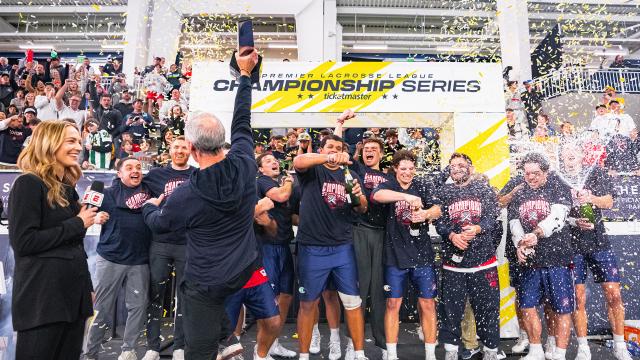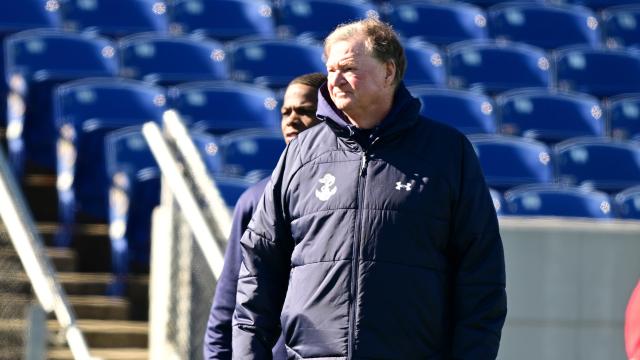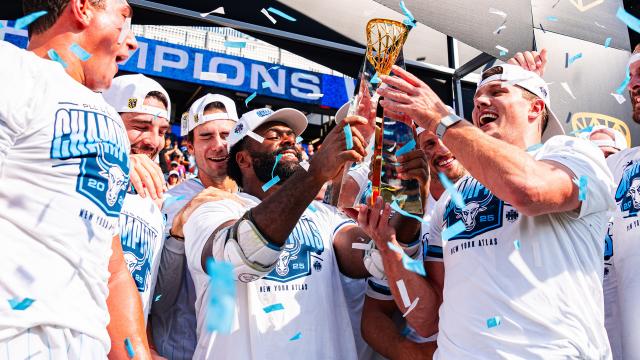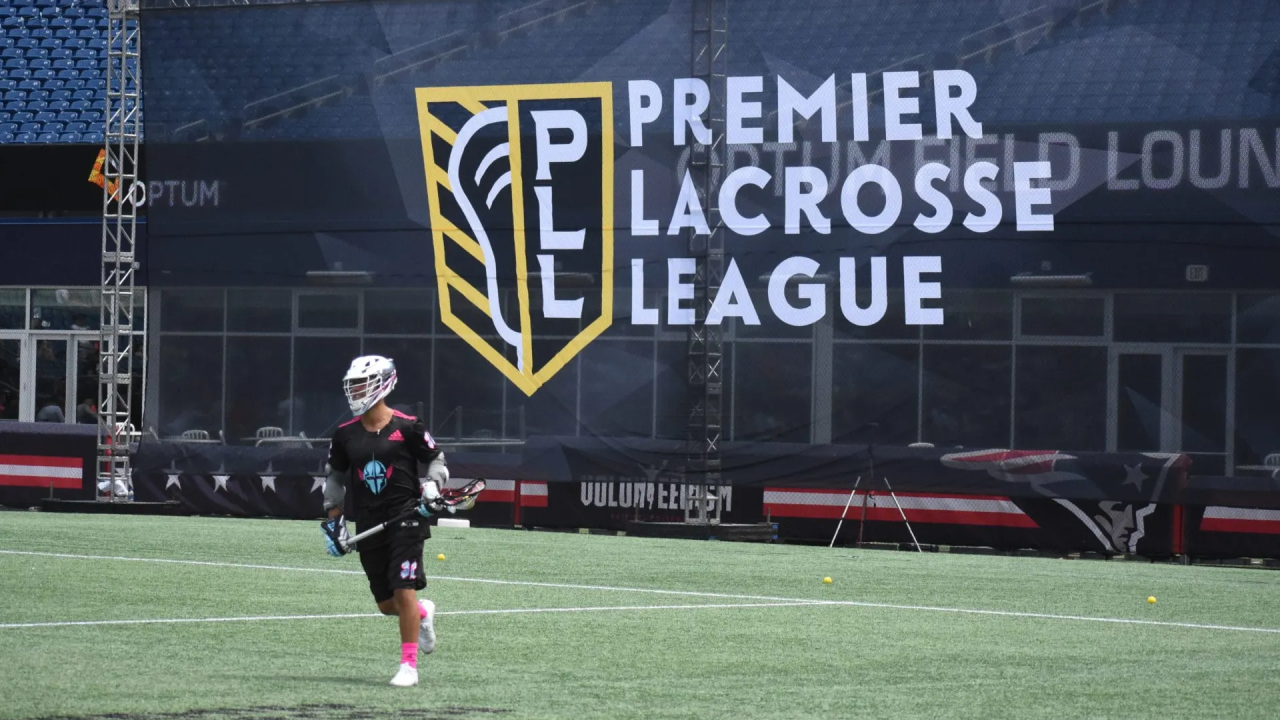
Paul Rabil, Investors and Players Reflect on 5th Anniversary of PLL's First Game
Tom Schreiber played in the first-ever game in the Premier Lacrosse League on June 1, 2019, a 13-12 Archers overtime victory over the Chrome.
Schreiber pulled double duty that week as a league operator. He joined the PLL not just as a player but also as a financial analyst who was the point of contact for many of the next players that would join the league.
He stuck around over the course of the weekend.
Paul Rabil, the league’s co-founder, was playing with the Atlas against the Redwoods and Kyle Harrison, another U.S. men’s national team alum who served as the league’s director of player relations.
After the game, the three lacrosse icons stood at midfield as other PLL employees broke down the field around them.
“We got a special moment on the field,” Rabil said, “of us just sitting in a circle, talking about the accomplishment of being able to get to that point and actually pull off these opening weekend games after, really, a year and a half of grueling work to get through all the challenges of standing this thing up in the face of competition in a really competitive sports climate.”
“Seeing it, nobody really has a blueprint for taking an idea to a sports league that’s on NBC, nonetheless,” Schreiber said. “It’s hard not to think of that moment as a pretty special one.”
As the 2024 season begins on June 1, the fifth anniversary of that very first weekend, Schreiber said it feels like the PLL has always been here. That could be because so much has happened in such a short period of time.
Heading into the first weekend in league history, there was a palpable buzz that hadn’t been felt in professional lacrosse, particularly the field game. It had been building since Rabil announced the league’s inception live on Bloomberg Television on October 22, 2018.
Not only were fans talking about professional lacrosse. The players and coaches were excited.
“I felt like [coaching the Charlotte Hounds] just wasn’t the commitment I was used to. Guys weren’t taken care of at the level I would call truly professional, so I was out,” Whipsnakes head coach Jim Stagnitta said. “When the PLL called, and I had conversations with Paul, to me, it reminded me of what my experience was in Denver, but elevated. That piqued my interest. I wasn’t going to jump back into something that wasn’t done at a high level and professional.”
One important area of growth for the PLL was raising the wage for players. According to an article on CNBC from June 2019, the average player salary in the MLL in 2018 was $8,000; the PLL average salary was $35,000 along with healthcare benefits and stock options. The minimum salary by 2021 was $25,000.
“In so many ways, it was able to raise the level of play because the stakes were higher and guys could play lacrosse more seriously and for a longer period of time,” Schreiber said. “Now guys can play until your body can’t support it anymore instead of outside factors like taking the next step in your career.”
One of those players affected was Mark Glicini.
The midfielder, now with the Chaos, was splitting time between the Chesapeake Bayhawks and working on Wall Street from 2016-18. He left Wall Street, pondering how he was going to make a living next. He called the creation of the PLL “a blessing”.
“It’s exactly what I needed when I needed it,” he said. “It allowed me to grow myself outside of the game. I’m pouring myself into sport and performance psychology. … I have this life outside of lacrosse that helped me from an identity perspective, but I love the way lacrosse is going, the Premier Lacrosse League, what they’ve done with NBC and now ESPN and partners alike. I think the sky is going to be the limit.”
Rabil said those at the highest levels of the sport weren’t capitalizing on marketing, communication and investment. He looked up to Jim Thorpe, an iconic Native athlete who played lacrosse and became the first commissioner of the NFL. He studied former NFL commissioner Pete Rozelle and how he came from the league’s marketing department and focused on selling football in America.
He looked at the David Stern era of the NBA and how they leveraged superstars like Magic Johnson, Larry Bird and Michael Jordan for non-endemic coverage of basketball. He learned from MLS commissioner Don Garber and watched how the MLS grew from 10 teams in 2004 to 19 teams 10 years later — and six more by the time the PLL started.
He even got a lesson from Peter Guber, CEO of Mandalay Entertainment and chairman of the Golden State Warriors, when he told Rabil, “Sports is showbusiness.”
If the announcement of the league was the movie trailer, the first weekend — when two games went to overtime and all three games were decided by a single possession — was the summer blockbuster.
“I have vivid memories of the opening faceoff of the first game at Foxboro and Stephen Kelly scoring,” Archers head coach Chris Bates said. “I remember the OT goal and celebrating with Scott Ratliff on the sideline. Seeing the TV coverage and how professionally it was done, every step of the way, the product has delivered.”
The play on the field was thrilling, but not every aspect was a smashing success.
One of the tentpoles the PLL tried to build on was playing in premier venues, and they swung for the fences early. They opened the season at Gillette Stadium, owned by PLL investor Robert Kraft and home of the New England Patriots. That stadium’s capacity is 65,878. A press release from the league announced an attendance of 13,681 as the total for all three games, an average of 4,560 for each contest.
Mike Levine, the Co-Head of Sports at Creative Artists Agency who was an investor in the league and was elected to the league’s Board of Directors in 2023, said it was an important lesson the league learned quickly.
“NFL venues, while they’re incredibly equipped and provide both the press and the players an opportunity to have facilities that are as good as anything, that’s just too big of a venue,” he said. “No matter what, you’re going to have a lot of empty seats, and it’s going to feel empty.
“You put that in contrast to the environment the PLL has created at the University of Albany over a weekend or out at Hofstra University on Long Island or at Homewood Field at Johns Hopkins, and those sellout crowds where you have kids standing around the side of the field, where every seat is filled, that creates an atmosphere that’s infectious. That really translates to a great TV product and an experience on site that people want to come back to and experience again and again.”
Rabil said that fourth week of games at Homewood Field in Baltimore, Md., was the weekend he felt the league cemented itself in the sporting landscape.
The Saturday night game featuring a Whipsnakes roster of mostly former Maryland Terrapins going against an Atlas team with numerous players from Johns Hopkins was a sellout.
People outside of the league were starting to take notice.
“Going through all of the media and marketing and press, being on the cover of The Baltimore Sun,” Rabil said, “all that stuff was like, ‘OK, we’re here, and we got here pretty quickly.’”
The league was ready to run it back in 2020. It welcomed the Waterdogs as an expansion team and announced the 12 cities and venues the league would play in for the regular season and All-Star Game, including the league’s first visits to Texas, Oregon, North Carolina and Utah.
As it turned out, Utah would be the only place the league would play that year. The pandemic scrapped the PLL’s original plans. Rabil shared a Google document with his brother and fellow co-founder Mike Rabil, as well as COO Andrew Sinnenberg, with 12 different scenarios. They landed on playing a bubble season: an abbreviated schedule in one spot, without fans — the first pro sports league to announce a return-to-play plan. The chosen venue was Zions Bank Stadium in Herriman, Utah.
The league was applauded for its execution of PLL Island. It reported an increase in viewers for all 14 of broadcasts, and more importantly, there wasn’t a single reported positive COVID-19 test.
Glicini, a member of the Players’ Council, said that was due to the league’s leadership.
“How they handled that situation, they went about it the right way,” he said. “The pandemic was a great inflection point to show the level of expertise and leadership we had.”
Rabil said if they knew a global pandemic was coming in 2020, they never would have launched the league. As a touring league, however, they were already equipped to handle all teams and employees at one site, which allowed them to come to a solution quicker than others.
There also was an opportunity for great exposure of the league and sport. The NCAA and NLL seasons were canceled, so lacrosse fans were hungry for action. Additionally, the Olympics had been pushed back a year, so then-television partner NBC had a gaping hole in its schedule.
“To have sort of that proving ground when people were still at home and watching the PLL potentially for the first time, that actually accelerated our business,” Rabil said. “The lesson there is through the most challenging times are often where the most opportunity lies.”
The next opportunity for the league was unification. The documentary Fate of a Sport revealed the PLL purchased its rival league, the MLL, for $1 million. The PLL expanded by one, rebranding the Boston Cannons as Cannons LC, and retained all MLL intellectual property and video footage.
Now, future All-Stars and league champions such as Lyle Thompson, Graeme Hossack and Liam Byrnes were able to join the fold. And pro lacrosse history was whole again.
“Bringing it all under one umbrella and taking away any confusion, and I don’t believe there was any competition once the PLL kicked off,” Stagnitta said, “it gave the guys who felt like they needed to be loyal to the MLL that opportunity to step away and be truly appreciated.”
It also connected the league to the MLL alumni that paved the way for the PLL. Rabil said it was a goal to make sure the stats and memories of former pros lived on, and a Professional Lacrosse Hall of Fame was created.
Owning the intellectual property of the MLL, including team names, logos and color schemes, was especially important in the latest mile marker on the PLL journey. The league assigned home cities for each team in November, looking to build a larger footprint in certain markets. One of those home cities was Denver, and it was agreed that professional lacrosse in Denver belonged to the Outlaws, so the league rebranded the Chrome back into one of the most successful franchises in MLL history.
When the PLL visits one of the home cities, that designated team will play two games over the weekend. One thing Chaos head coach Andy Towers hopes to see in the future is even more games in a team’s home market.
“Have us play six games a year in our respective cities,” he said. “The season is too quick, and everybody is so bummed out when it’s over, the players, the coaches and the fans. I think if we were able to push the start of the season back to the beginning of April, and each team was playing 25 games, I think we’d be able to have guy move to specific geographic locations. We’d be able to have more team practices. That would increase the quality of the play on gameday, which would increase the quality of the fan experience. It just seems like the next logical step.”
Levine offers a unique perspective for the league. Through his children, he’s seen the level of interest young lacrosse players have. Whereas professional teams and players were often unknown to younger players, Levine said his son and his teammates can rattle off long lists of favorite players and who they play for without hesitation.
He gives the credit for that to the PLL’s focus on content and engagement through social media not just in season but throughout the year.
“If you’re a lacrosse fan, or you’re a casual sports fan, you can’t go very long without seeing compelling content about the sport of lacrosse,” he said. “That digital engagement that Jimmy Pitaro and Burke Magnus and the team at ESPN saw, when they were bidding to be the media rights partner of the PLL, that was as important a metric as there was.
“Paul and Mike were super smart by recognizing that my kids, and the kids of that generation, that’s where they’re consuming sports. That’s where they’re engaging with brands like Whipsnakes and Waterdogs and Atlas. These players, underneath their helmets, are able to connect with my son, and his teammates and friends. That’s what’s making the difference to creating a fan base that’s here to stay and as young, if not younger, than any fan base in America.”
When the MLL wasn’t meeting the needs of its players nor growing the profile of the sport, Rabil believed he could do it better. It’s a mindset he continues to display in the decision-making process regarding league issues.
One example is PLL Collectibles. The league previously issued three different sets of trading cards through Topps. When the league couldn’t come to an agreement with their partner to continue issuing new sets, they took matters into their own hands and created their own vertical for collectible memorabilia and merchandise.
It’s all part of the disruptor mindset, said Rabil.
“We don’t take no for an answer,” he said. “I’ve been told no my whole life when it comes to lacrosse, by brands that are not endemic to the space, by some endemic brands, by former commissioners of pro lacrosse, by members of media, at times by head coaches of universities that I respect, by athletic department commissioners.
“People didn’t believe in lacrosse, and that was unacceptable for me because I knew the game’s history. There was some passionate bias in there because I loved the game as a player, but there was also data to back it that millions of others also loved it the way I did, so I just think no is unacceptable, and we have to continue to carry that solution-oriented mindset when it comes to a partnership or an opportunity that we believe in.”
The league isn’t done making waves yet, either.
The league is looking toward lacrosse’s inclusion in the 2028 Los Angeles Olympics. The PLL was part of a collective effort to persuade the International Olympic Committee’s executive board to include lacrosse. The PLL has run the Championship Series, a week-long winter tournament featuring the league’s top four teams from the regular season, as a version of Sixes lacrosse that will be played in the Olympics.
Long-term, Levine said the league would like to bring partners into the league who will have some version of team ownership. He hopes to see PLL-specific venues down the road.
Rabil knows achieving these lofty aspirations are going to take double or triple the amount of work. For him, reflecting on the creation of the league reminds him of the amount of work that’s already gone into some of the biggest moments in league history.
It floods him with gratitude that helps him prepare to help take the league to the next level.
“There will be some improvements and potentially some changes in the way the league currently operates, the way the league will continue to grow into new markets and in front of as many people in as many different sized screens at any moment during the day,” he said. “I think the next four years are going to be bigger than the first five. I’m excited to be a part of it with the rest of the lacrosse community.”
Phil Shore
Phil Shore has covered lacrosse for a variety of publications. He played Division III lacrosse at Emerson College and is the current head coach at Osbourn Park High School in Virginia. His first book, Major League Life, was published in June 2020. Shore has contributed to USA Lacrosse Magazine since 2011.
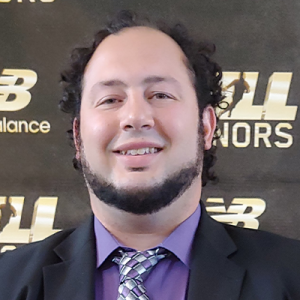
Categories
Related Articles
